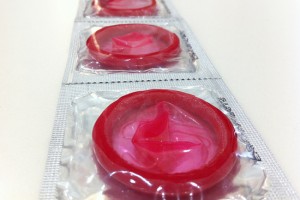MED Prof Wins Gates Foundation Condom Challenge
$100,000 grant for radiologist’s next-generation design

- Building a better condom: MED Professor Ducksoo Kim has won a $100,000 grant from the Bill and Melinda Gates Foundation to develop a self-lubricating “next-generation” condom. Photo by Flickr contributor Kerry J.
Condoms are a cheap, universally accessible means of preventing unwanted pregnancy and reducing the spread of HIV and other sexually transmitted diseases. But condoms aren’t nearly as effective as they should be for one stark reason: most men don’t like using them. So as part of its ongoing Grand Challenges Explorations Programs, the Bill and Melinda Gates Foundation asked researchers to come up with a “next generation” of male condoms that would be easier to use and preserve or enhance sexual pleasure. The foundation awarded phase one grants to develop an improved condom to 11 researchers, one a Boston University School of Medicine radiologist whose team has received a $100,000 grant to pursue development of a self-lubricating condom that would not only be more durable and more resilient, but would make protected sex more pleasurable.
Ducksoo Kim, director of the vascular and interventional radiology fellowship at Boston Medical Center, will lead the project, along with Karen Buch, a BMC third-year radiology resident. They are working to create condoms with a coating of superhydrophilic nanoparticles—tiny particles that trap water. The result would be a condom that would allow more sensitivity and make the use of lubricants unnecessary, says Kim. Like the other winning proposals, which include a “reconstituted collagen” condom made from beef, a gradually tightening condom, and a condom constructed of the ultrathin crystalline carbon known as graphene, the self-lubricating design would be a significant change in a product that hasn’t evolved all that much in centuries of use.
BU Today asked Kim what drew him to the challenge and what it will take to perfect and produce a condom that lubricates itself.
BU Today: How did you become interested in developing a better condom?
Kim: As physicians, we have dedicated our careers to helping our patients through the diagnosis and treatment of disease. Our research efforts have a similar focus on providing better and safer medical devices that would allow for earlier disease detection or prevent disease transmission. This project was a natural fit for us given our research focus.
What does winning the Gates Foundation challenge mean to you and your colleagues?
We feel very honored and happy that our innovative idea was recognized by this prestigious grant. And we are looking to collaborate with other BU scientists, and we invite them to contact us at dukim@bu.edu. The $100,000 award is for phase one, and we can apply for a follow-up grant worth $1 million in order to further the project.
Is your interest in nanoparticles unusual for a radiologist? Can you explain how your field applies to this line of research?
Not unusual at all. Radiologists are performing almost every single procedure using hydrophilic devices, which facilitate the procedures and improve their technical success and clinical outcome.
What are the major problems with the current generation of condoms?
The polymer or latex materials used in the current generation do not have this hydrophilic coating and so create significant friction and shearing forces. The use of additional lubricants to coat current condoms is an added step with increased cost to users.
How would a nano-lubricated condom be an improvement?
The hydrophilic coating drastically alters the mechanical forces and decreases friction to improve its functionality. That minimizes trauma to body tissues and ultimately lowers rates of breakage. This feature would decrease the rates of infection transmission and decrease the rate of unwanted pregnancy.
How does the hydrophilic coating work?
The hydrophilic coating traps water so that it reduces friction between the condom and tissue.
What are some of the other applications of nanoparticle technology?
The use of nanoparticles in medicine and biological sciences is at an all-time high. This technology was initially discovered and refined in the engineering sector, and it has a growing influence in medical devices, pharmaceuticals and drug delivery, gene therapy, contrast agents, tissue engineering, nanoscale biopchips, and microsurgical technology.
Would the nanolubricated condom look different from ordinary condoms?
No. The hydrophilic coating would not change the overall look of a typical condom.
Would the condoms be more expensive to produce?
Not at all. The goal of this condom is to be of low cost to users to increase condom use.
Would these condoms eliminate the need for lubricants?
Yes, that will be one of the major benefits. It will be more convenient, handy and ready for use without the need for extra lubricants. It will avoid potential contamination of germs from manual application of those lubricants.
What are the obstacles to developing and mass-producing nano-lubricated condoms for everyday use?
The main obstacles are the refinement of materials and extra processing of the coating materials to be compatible with mass production techniques, and maintaining high quality.
How do you plan to test the condoms’ strength and durability?
There are industrial standards that require electrical current testing for the existence of any porous defects (holes or tears) and a test that involves inflation and deflation of the condom hundreds or thousands of times to test its strength and durability.
This BU Today story was written by Susan Seligson. She can be reached at sueselig@bu.edu.
View all posts